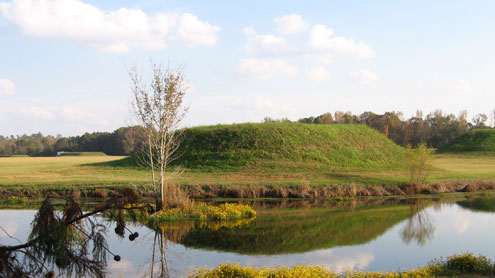Just over 15 miles from the University of Alabama campus on the banks of the Black Warrior River, Moundville was once a cosmopolitan city with at least 3,000 Native American inhabitants living within the one-mile fortified wall and an additional 10,000 settled in the outlying land.
“When you’re looking at the mounds, you’re really looking at the ruins of an ancient city,” Bill Bomar, director of the park, said.
Called “The Big Apple of the 14th century” by National Geographic, Moundville Archeological Park is the second largest mound site in the U.S. and home to 26 mounds of varying sizes. Although thought to be burial mounds by many, Jeremy Davis, a doctoral student who studies the site, said the mounds of Moundville were architectural features built to elevate the home sites for elite people in the village.
“There are burials in there,” Davis said. “But there really are none in the big mounds that we know of. The burials that are there are few, and they’re in the smaller ones.”
Most of the items found in the mounds are refuge from everyday living, Davis said. Every so often, a team will come across a dedicatory offering, such as three or four pots clustered together in the corner of where a building once stood.
“It was like cracking the champagne up against the ship,” Davis said.
Moundville Archeological Park opened to the public during the Great Depression in 1939, Bomar said. Walter B. Jones, the state geologist, recognized the significance of the site and the need to preserve it to prevent erosion.
In a time where money was little and the number of individuals in need of jobs was high, Jones was able to set a Civilian Conservation Camp at the site. Members of CCC constructed the orientation building, museum building and roadways throughout the park, Bomar said.
The University acquired the park and assumed ownership in 1961 but had long been associated with the park in various ways.
“There are special advantages to having a site like this owned and operated by a research university,” Bomar said. “For one, we really echo the University’s mission of education, research and public service because what we have at the heart of what we do here is education and sharing with the public information knowledge based on the research we do here.”
Davis, originally from Savannah, Ga., came to the University to study Moundville from his undergraduate studies at the University of Georgia.
“This was the place to come if you were interested in the site,” he said. “Also, the relationship the University has with this site is unique. The fact that the University owns this site is unique, so it helps with people like me who want to study it and want to have access to it for excavations.”
More than 800 years ago, around 1120 AD, a blended group of Native American tribes settled in the area, Davis said. By 1250 AD, the population peaked and due to political and factional disputes, the abandonment of the site began by 1400 and by the end of the decade, only a small group lived around the largest mound.
“In a place where you have a chief who has exclusive claim to that office, a person who has that claim because they are born into it, that’s kind of a contentious thing and a lot of people want that position,” he said. “You can draw a direct parallel to Tudor England and disputes over who is going to have what position, that same sort of thing happened in Moundville. It happens in every ranked society like that.”
Inhabitants came from different tribes, but the specific tribes are unknown because there was no writing system, Bomar said. Possible ancestors of the Moundville people include the Choctaw, Chickasaw and Creek tribes.
The Moundville Archeological Park museum, which underwent $5 million in renovations a few years ago, contains 250 artifacts, including the famous Moundville Duck Bowl, which according to Bomar, is arguably the most important prehistoric artifact found in the United States.
“We wanted to adequately tell the story of the ancient Moundville people through an immersive exhibit that really brought the culture to life,” Bomar said. “[We also wanted] to balance that with a presentation of the artifacts that really reflected the sophistication of the Moundville people.”
A group of Native American advisors, archeologists, folklorists, exhibit designers and educators came together nine years ago to create a storyline, that of a group arriving at Moundville, and plan other details of the museum, Bomar said.
Native American artists painted the murals on the walls and created many of the exhibits, Bomar said. Native American models were also used for the figures in the exhibits with artists from New York taking molds of their heads.
In addition to the annual Native American Festival held each October, the park offers guided tours for school groups and a menu of other services like Native American dance and art, Bomar said. The site also has hiking trails and offers audio tours, a recreated Indian village, a conference center overlooking the Black Warrior that can be rented and 28 campsites.
The University’s anthropology department is offering an eight-week field course this summer for students of any major, David said. ANT 269 is a six-hour class that offers a rare opportunity for students to dig at the park.
“Moundville’s history is America’s history,” he said. “Why do we look to Egypt to talk about human past when we have these amazing cultures right here in the southeast like Moundville?”
[IF YOU GO]
Where: 13075 Moundville Archeological Park, Moundville, AL 35474
When: park grounds are open daily from 9 a.m. until dusk, museum from 9 a.m. to 5 p.m.
Cost: $6 for students and children, $7 for seniors and $8 for adults







